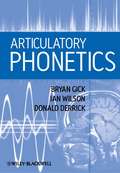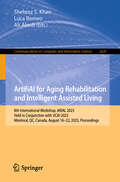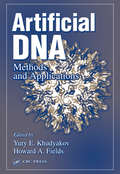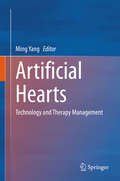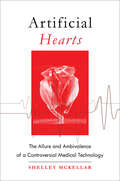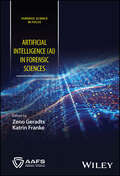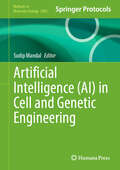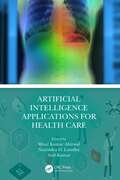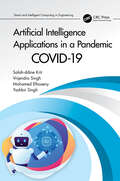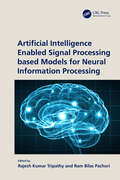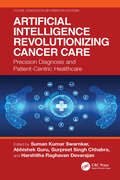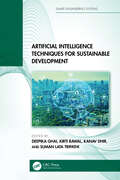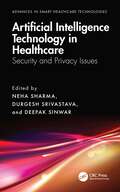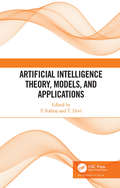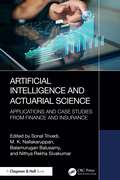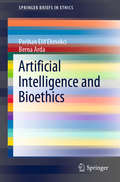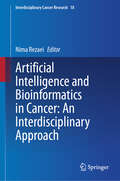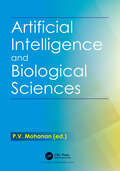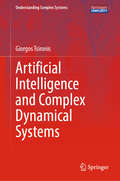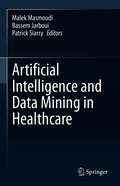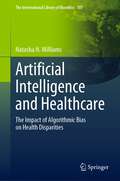- Table View
- List View
Articulatory Phonetics
by Ian Wilson Bryan Gick Donald DerrickArticulatory Phonetics presents a concise and non-technical introduction to the physiological processes involved in producing sounds in human speech. <P><P>Traces the path of the speech production system through to the point where simple vocal sounds are produced, covering the nervous system, and muscles, respiration, and phonation Introduces more complex anatomical concepts of articulatory phonetics and particular sounds of human speech, including brain anatomy and coarticulation <P><P>Explores the most current methodologies, measurement tools, and theories in the field <P>Features chapter-by-chapter exercises and a series of original illustrations which take the mystery out of the anatomy,physiology, and measurement techniques relevant to speech research <P><P>Includes a companion website atwww.wiley.com/go/articulatoryphonetics with additional exercisesfor each chapter and new, easy-to-understand images of the vocal tract and of measurement tools/data for articulatory phonetics teaching and research
ArtifiAI for Aging Rehabilitation and Intelligent Assisted Living: 8th International Workshop, ARIAL 2025, Held in Conjunction with IJCAI 2025, Montreal, QC, Canada, August 16-22, 2025, Proceedings (Communications in Computer and Information Science #2620)
by Ali Abedi Shehroz S. Khan Luca RomeoThis book constitutes the refereed proceedings of the 8th International Workshop on ArtifiAI for Aging Rehabilitation and Intelligent Assisted Living, ARIAL 2025, Held in Conjunction with IJCAI 2025, Montreal, QC, Canada, August 16-22, 2025, Proceedings. The 10 full papers presented in this volume were carefully reviewed and selected from 14 submissions. They are grouped into the following topics: Multimodal data collection; Telemedicine; Sensor-based remote monitoring; Privacy-preserving algorithms; and Generative AI in elderly care.
Artificial DNA: Methods and Applications
by Yury E. Khudyakov Howard A. FieldsCombining elements of biochemistry, molecular biology, and immunology, artificial DNA can be employed in a number of scientific disciplines. Some of the varied applications include site-specific mutagenesis, hybridization, amplification, protein engineering, anti-sense technology, DNA vaccines, protein vaccines, recombinant antibodies, screening fo
Artificial Hearts: Technology and Therapy Management
by Ming YangThis book provides a comprehensive introduction to artificial hearts, summarizing the latest advances in basic technologies, design, evaluation, and management. Featuring 11 chapters, it discusses the origins of the artificial heart, the mechanisms of heart failure, and the principles of artificial heart technologies. Further, it offers an overview of rotary pumps and volume-displacement pumps, and addresses total artificial hearts. Lastly, the book covers evaluation, selection, therapy management, challenges, and the latest innovations. Given its scope, it is a valuable resource for researchers and technicians in the area of biomedical engineering, as well as surgeons.
Artificial Hearts: The Allure and Ambivalence of a Controversial Medical Technology
by Shelley McKellarA comprehensive history of the development of artificial hearts in the United States.Artificial hearts are seductive devices. Their promissory nature as a cure for heart failure aligned neatly with the twentieth-century American medical community’s view of the body as an entity of replacement parts. In Artificial Hearts, Shelley McKellar traces the controversial history of this imperfect technology beginning in the 1950s and leading up to the present day. McKellar profiles generations of researchers and devices as she traces the heart’s development and clinical use. She situates the events of Dr. Michael DeBakey and Dr. Denton Cooley’s professional fall-out after the first artificial heart implant case in 1969, as well as the 1982–83 Jarvik-7 heart implant case of Barney Clark, within a larger historical trajectory. She explores how some individuals—like former US Vice President Dick Cheney—affected the public profile of this technology by choosing to be implanted with artificial hearts. Finally, she explains the varied physical experiences, both negative and positive, of numerous artificial heart recipients. McKellar argues that desirability—rather than the feasibility or practicality of artificial hearts—drove the invention of the device. Technical challenges and unsettling clinical experiences produced an ambivalence toward its continued development by many researchers, clinicians, politicians, bioethicists, and the public. But the potential and promise of the artificial heart offset this ambivalence, influencing how success was characterized and by whom. Packed with larger-than-life characters—from dedicated and ardent scientists to feuding Texas surgeons and brave patients—this book is a fascinating case study that speaks to questions of expectations, limitations, and uncertainty in a high-technology medical world.
Artificial Intelligence (Forensic Science in Focus)
by Katrin Franke Zeno GeradtsARTIFICIAL INTELLIGENCE (AI) IN FORENSIC SCIENCES Foundational text for teaching and learning within the field of Artificial Intelligence (AI) as it applies to forensic science Artificial Intelligence (AI) in Forensic Sciences presents an overview of the state-of-the-art applications of Artificial Intelligence within Forensic Science, covering issues with validation and new crimes that use AI; issues with triage, preselection, identification, argumentation and explain ability; demonstrating uses of AI in forensic science; and providing discussions on bias when using AI. The text discusses the challenges for the legal presentation of AI data and interpretation and offers solutions to this problem while addressing broader practical and emerging issues in a growing area of interest in forensics. It builds on key developing areas of focus in academic and government research, providing an authoritative and well-researched perspective. Compiled by two highly qualified editors with significant experience in the field, and part of the Wiley — AAFS series ‘Forensic Science in Focus’, Artificial Intelligence (AI) in Forensic Sciences includes information on: Cyber IoT, fundamentals on AI in forensic science, speaker and facial comparison, and deepfake detection Digital-based evidence creation, 3D and AI, interoperability of standards, and forensic audio and speech analysis Text analysis, video and multimedia analytics, reliability, privacy, network forensics, intelligence operations, argumentation support in court, and case applications Identification of genetic markers, current state and federal legislation with regards to AI, and forensics and fingerprint analysis Providing comprehensive coverage of the subject, Artificial Intelligence (AI) in Forensic Sciences is an essential advanced text for final year undergraduates and master’s students in forensic science, as well as universities teaching forensics (police, IT security, digital science and engineering), forensic product vendors and governmental and cyber security agencies.
Artificial Intelligence (Methods in Molecular Biology #2952)
by Sudip MandalThis volume focuses on how different artificial intelligence (AI) techniques like Artificial Neural Network, Support Vector Machine, Random Forest, k-means Clustering, Rough Set Theory, and Convolutional Neural Network models are used in areas of cell and genetic engineering. The chapters this book cover a variety of topics such as molecular modelling in drug discovery, design of precision medicine, protein structure prediction, and analysis using AI. Readers can also learn about AI-based biomolecular spectroscopy, cell culture-system, AI-based drug discovery, and next generation sequencing. The book also discusses the application of AI in analysis of genetic diseases such as finding genetic insights of oral and maxillofacial cancer, early screening and diagnosis of autism, and classification of breast cancer microarray data. Written in the highly successful Methods in Molecular Biology series format, chapters include introductions to their respective topics, lists of the necessary materials and reagents, step-by-step, readily reproducible laboratory protocols, and tips on troubleshooting and avoiding known pitfalls.Cutting-edge and thorough, Artificial Intelligence (AI) in Cell and Genetic Engineering is a valuable resource for readers in various research communities who want to learn more about the real-life application of artificial intelligence and machine learning in systems biology, biotechnology, bioinformatics, and health-informatics especially in the field of cell and genetic engineering.
Artificial Intelligence Applications for Health Care
by Anil Kumar Mitul Kumar Ahirwal Narendra D. LondheThis book takes an interdisciplinary approach by covering topics on health care and artificial intelligence. Data sets related to biomedical signals (ECG, EEG, EMG) and images (X-rays, MRI, CT) are explored, analyzed, and processed through different computation intelligence methods. Applications of computational intelligence techniques like artificial and deep neural networks, swarm optimization, expert systems, decision support systems, clustering, and classification techniques on medial datasets are explained. Survey of medical signals, medial images, and computation intelligence methods are also provided in this book. Key Features Covers computational Intelligence techniques like artificial neural networks, deep neural networks, and optimization algorithms for Healthcare systems Provides easy understanding for concepts like signal and image filtering techniques Includes discussion over data preprocessing and classification problems Details studies with medical signal (ECG, EEG, EMG) and image (X-ray, FMRI, CT) datasets Describes evolution parameters such as accuracy, precision, and recall etc. This book is aimed at researchers and graduate students in medical signal and image processing, machine and deep learning, and healthcare technologies.
Artificial Intelligence Applications in a Pandemic: COVID-19 (Smart and Intelligent Computing in Engineering)
by Salah-Ddine KritCOVID-19, a novel coronavirus pandemic has disrupted our society in many ways. Digital healthcare innovations are required more than ever before as we come across myriad challenges during this pandemic. Scientists and developers are learning and finding a way to use artificial intelligence applications and natural language processing to comprehend and tackle this disease. AI technologies are playing an important role in the response to the COVID-19 pandemic. Experts are using all possible tools to study the virus, diagnose individuals, and analyze the public health impacts. This book is a collection of some of the leading efforts related to AI and COVID-19 focused on finding how AI can be helpful in monitoring the situation from early warnings, swift emergency responses, and critical decision-making. It discusses the use of machine learning and how it may help to reduce the impacts of this pandemic in conjunction with all other research and strategies going on. The book serves as a technical resource of data analytics and AI applications in tracking infectious diseases. It will serve academics, students, data scientists, medical practitioners, and anybody managing a global pandemic. Features: Directs the attention to the smart digital healthcare system in this COVID-19 pandemic. Simulates novel investigations and how they will be beneficial in understanding the pandemic. Presents the latest ideas developed for data scientists, doctors, engineers, and economists. Analyses the various issues related to computing, AI apps, big data analytic techniques, and predictive scientific skill gaps. Explains some interesting and diverse types of challenges and data-driven healthcare applications.
Artificial Intelligence Enabled Signal Processing based Models for Neural Information Processing
by Ram Bilas Pachori Rajesh Kumar TripathyThe book provides details regarding the application of various signal processing and artificial intelligence-based methods for electroencephalography data analysis. It will help readers in understanding the use of electroencephalography signals for different neural information processing and cognitive neuroscience applications. The book: Covers topics related to the application of signal processing and machine learning-based techniques for the analysis and classification of electroencephalography signals Presents automated methods for detection of neurological disorders and other applications such as cognitive task recognition, and brain-computer interface Highlights the latest machine learning and deep learning methods for neural signal processing Discusses mathematical details for the signal processing and machine learning algorithms applied for electroencephalography data analysis Showcases the detection of dementia from electroencephalography signals using signal processing and machine learning-based techniques It is primarily written for senior undergraduates, graduate students, and researchers in the fields of electrical engineering, electronics and communications engineering, and biomedical engineering.
Artificial Intelligence Revolutionizing Cancer Care: Precision Diagnosis and Patient-Centric Healthcare (Future Generation Information Systems)
by Suman Kumar Swarnkar Gurpreet Singh Chhabra Abhishek Guru Harshitha Raghavan DevarajanIn the ever-evolving landscape of cancer treatment, the fusion of artificial intelligence (AI) with medical science marks a groundbreaking shift toward more precise, efficient, and personalized healthcare. Artificial Intelligence Revolutionizing Cancer Care: Precision Diagnosis and Patient-Centric Healthcare delves into the transformative power of AI, offering a comprehensive exploration of its role in enhancing cancer diagnosis, treatment, and patient management. This edited volume brings together leading experts and researchers who illuminate the latest advancements in AI technologies applied to oncology. From machine learning algorithms that predict cancer progression to sophisticated imaging techniques that improve diagnostic accuracy, this book covers a spectrum of innovations reshaping cancer care. Key highlights include precision diagnosis, uncovering how AI-driven tools are revolutionizing the early detection and accurate classification of various cancer types, leading to better patient outcomes; patient-centric approaches, exploring the shift toward personalized medicine, where AI tailors treatment protocols to individual patient profiles, ensuring more effective and targeted therapies; and ethical and practical considerations, gaining insights into the ethical, practical, and regulatory challenges of integrating AI in healthcare, emphasizing the need for patient privacy and data security. Additionally, the book looks ahead to the potential future applications of AI in oncology, including predictive analytics, robotic surgery, and beyond. Artificial Intelligence Revolutionizing Cancer Care is an essential resource for medical professionals, researchers, and students seeking to understand the intersection of AI and oncology. It offers a visionary perspective on how cutting-edge technology is poised to enhance patient care and transform the fight against cancer.This book focuses on the critical intersection of artificial intelligence and cancer diagnosis within the healthcare sector emphasizes the real-world impact of artificial intelligence in improving cancer detection, treatment, and overall patient care covers artificial intelligence algorithms, machine learning techniques, medical image analysis, predictive modeling, and patient care applications explores how artificial intelligence technologies enhance the patient’s experience, resulting in better outcomes and reduced healthcare disparities provides readers with an understanding of the mathematics underpinning machine learning models, including decision trees, support vector machines, and deep neural networks It is primarily written for senior undergraduates, graduate students, and academic researchers in the fields of electrical engineering, electronics and communications engineering, computer science and engineering, biomedical engineering, and information technology.
Artificial Intelligence Techniques for Sustainable Development (Smart Engineering Systems: Design and Applications)
by Suman Lata Tripathi Kanav Dhir Deepika Ghai Kirti RawalHow can the efficiency of the algorithms be increased with a lesser number of computations as well as optimized with the resources for cost-effective solutions? Artificial Intelligence Techniques for Sustainable Development provides an answer. Further, it discusses important concepts such as green communication network design and implementation for the Internet of Things ecosystem, green computing in network security, and artificial intelligence models for remote sensing applications.Key features: Presents the latest tools and techniques in developing solutions intended for resource utilization, energy efficiency, and human and environmental health Highlights the advancement in electronics and communication technology for green applications Covers smart energy harvesting/charging and power management techniques using machine learning Explains green communication network design and implementation for the Internet of Things ecosystem, and green computing in network security Illustrates prediction models for carbon emission and sequestration, environmental health, and climate change The book is aimed at senior undergraduates, graduate students, and academic researchers in the fields of electrical engineering, electronics, and communications engineering, computer science and engineering, environmental engineering, and biomedical engineering.
Artificial Intelligence Technologies for Computational Biology
by Ranjeet Kumar Rout Saiyed Umer Sabha Sheikh Amrit Lal SangalThis text emphasizes the importance of artificial intelligence techniques in the field of biological computation. It also discusses fundamental principles that can be applied beyond bio-inspired computing.It comprehensively covers important topics including data integration, data mining, machine learning, genetic algorithms, evolutionary computation, evolved neural networks, nature-inspired algorithms, and protein structure alignment. The text covers the application of evolutionary computations for fractal visualization of sequence data, artificial intelligence, and automatic image interpretation in modern biological systems.The text is primarily written for graduate students and academic researchers in areas of electrical engineering, electronics engineering, computer engineering, and computational biology.This book:• Covers algorithms in the fields of artificial intelligence, and machine learning useful in biological data analysis.• Discusses comprehensively artificial intelligence and automatic image interpretation in modern biological systems.• Presents the application of evolutionary computations for fractal visualization of sequence data.• Explores the use of genetic algorithms for pair-wise and multiple sequence alignments.• Examines the roles of efficient computational techniques in biology.
Artificial Intelligence Technology in Healthcare: Security and Privacy Issues (Advances in Smart Healthcare Technologies)
by Neha Sharma Deepak Sinwar Durgesh SrivastavaArtificial Intelligence Technology in Healthcare: Security and Privacy Issues focuses on current issues with patients’ privacy and data security including data breaches in healthcare organizations, unauthorized access to patients’ information, and medical identity theft. It explains recent breakthroughs and problems in deep learning security and privacy issues, emphasizing current state-of-the-art methods, methodologies, implementation, attacks, and countermeasures. It examines the issues related to developing artifiicial intelligence (AI)-based security mechanisms which can gather or share data across several healthcare applications securely and privately. Features: Combines multiple technologies (i.e., Internet of Things [IoT], Federated Computing, and AI) for managing and securing smart healthcare systems. Includes state-of-the-art machine learning, deep learning techniques for predictive analysis, and fog and edge computing-based real-time health monitoring. Covers how to diagnose critical diseases from medical imaging using advanced deep learning-based approaches. Focuses on latest research on privacy, security, and threat detection on COVID-19 through IoT. Illustrates initiatives for research in smart computing for advanced healthcare management systems. This book is aimed at researchers and graduate students in bioengineering, artificial intelligence, and computer engineering.
Artificial Intelligence Theory, Models, and Applications
by P. KalirajThis book examines the fundamentals and technologies of Artificial Intelligence (AI) and describes their tools, challenges, and issues. It also explains relevant theory as well as industrial applications in various domains, such as healthcare, economics, education, product development, agriculture, human resource management, environmental management, and marketing. The book is a boon to students, software developers, teachers, members of boards of studies, and researchers who need a reference resource on artificial intelligence and its applications and is primarily intended for use in courses offered by higher education institutions that strive to equip their graduates with Industry 4.0 skills. FEATURES: Gender disparity in the enterprises involved in the development of AI-based software development as well as solutions to eradicate such gender bias in the AI world A general framework for AI in environmental management, smart farming, e-waste management, and smart energy optimization The potential and application of AI in medical imaging as well as the challenges of AI in precision medicine AI’s role in the diagnosis of various diseases, such as cancer and diabetes The role of machine learning models in product development and statistically monitoring product quality Machine learning to make robust and effective economic policy decisions Machine learning and data mining approaches to provide better video indexing mechanisms resulting in better searchable results ABOUT THE EDITORS: Prof. Dr. P. Kaliraj is Vice Chancellor at Bharathiar University, Coimbatore, India. Prof. Dr. T. Devi is Professor and Head of the Department of Computer Applications, Bharathiar University, Coimbatore, India.
Artificial Intelligence Versus Natural Intelligence
by Roger Penrose Emanuele Severino Ines Testoni Fabio Scardigli Giuseppe Vitiello Federico Faggin Giacomo Mauro D'ArianoThis book centers around a dialogue between Roger Penrose and Emanuele Severino about one of most intriguing topics of our times, the comparison of artificial intelligence and natural intelligence, as well as its extension to the notions of human and machine consciousness.Additional insightful essays by Mauro D'Ariano, Federico Faggin, Ines Testoni, Giuseppe Vitiello and an introduction of Fabio Scardigli complete the book and illuminate different aspects of the debate. Although from completely different points of view, all the authors seem to converge on the idea that it is almost impossible to have real "intelligence" without a form of "consciousness". In fact, consciousness, often conceived as an enigmatic "mirror" of reality (but is it really a mirror?), is a phenomenon under intense investigation by science and technology, particularly in recent decades. Where does this phenomenon originate from (in humans, and perhaps also in animals)? Is it reproducible on some "device"? Do we have a theory of consciousness today? Will we arrive to build thinking or conscious machines, as machine learning, or cognitive computing, seem to promise? These questions and other related issues are discussed in the pages of this work, which provides stimulating reading to both specialists and general readers.The Chapter "Hard Problem and Free Will: An Information-Theoretical Approach" is available open access under a Creative Commons Attribution 4.0 International License via link.springer.com.
Artificial Intelligence and Actuarial Science: Applications and Case Studies from Finance and Insurance
by Balamurugan Balusamy Sonal Trivedi Nallakaruppan M. K Nithya Rekha SivakumarThis book aims to explore how to automate, innovate, design, and deploy emerging technologies in actuarial work transformations for the insurance and finance sector. It examines the role of artificial intelligence with process automation in daily monitoring of solvency, governance, compliance, data processes, etc. It also explores the usage of machine learning, telematics system, AI-enabled claim processing software, Big Data and Algorithms, Explainable AI, and AI-enabled risk management tools in various actuarial processes.This book:• Presents case studies and best practices with real-world examples of successful and unsuccessful actuarial work transformation initiatives and transformation with emerging technologies• Offers deployment solutions for different applications of AI in actuarial work• Discusses how organizations can effectively incorporate AI into their current practices of actuarial work• Covers diverse emerging technologies, practices, and processes of actuaries from around the globe• Elaborates upon a framework for comprehending how big data and AI developments may affect insurance offers and their supervision• Explains how insurance companies may review and modify their current Risk Management Framework (RMF) to take into account some of the significant differences while implementing AI use casesThis reference book is for scholars, researchers and professionals interested in Artificial Intelligence and Actuarial Science.
Artificial Intelligence and Autoimmune Diseases: Applications in the Diagnosis, Prognosis, and Therapeutics (Studies in Computational Intelligence #1133)
by Khalid Raza Surender SinghThe book provides an overview of various autoimmune disorders and how artificial intelligence (AI) and machine learning will be used for the diagnosis, prognosis, and treatment of these disorders. AI algorithms are used to create synthetic patient populations with the properties of actual patient cohorts, build personalized predictive models of drug combinations and unravel complex relationships between diet, microbiome, and genetic line-up to determine the comparative treatment response. The book highlights clinical applications and challenges of AI for the diagnosis and treatment/management of autoimmune disorders which includes Rheumatoid Arthritis (RA), Multiple Sclerosis (MS), Type I Diabetes, Psoriatic Arthritis (PsA), and other critical diseases.
Artificial Intelligence and Bioethics (SpringerBriefs in Ethics)
by Perihan Elif Ekmekci Berna ArdaThis book explores major bioethical issues emerging from the development and use of artificial intelligence in medical settings. The authors start by defining the past, present and future of artificial intelligence in medical settings and then proceed to address the resulting common and specific bioethical inquiries. The book discusses bioethical inquiries in two separate sets. The first set is comprised of ontological discussions mainly focusing on personhood and being an ethical agent of an artefact. The second set discusses bioethical issues resulting from the use of artificial intelligence. It focuses particularly on the area of artificial intelligence use in medicine and health services. It addresses the main challenges by considering fundamental principles of medical ethics, including confidentiality, privacy, compassion, veracity and fidelity. Finally, the authors discuss the ethical implications of involvement of artificial intelligence agents in patient care by expanding on communication skills in a case-based approach. The book is of great interest to ethicists, medical professionals, academicians, engineers and scientists working with artificial intelligence.
Artificial Intelligence and Bioinformatics in Cancer: An Interdisciplinary Approach (Interdisciplinary Cancer Research #18)
by Nima RezaeiThe &“Artificial Intelligence and Bioinformatics in Cancer: An Interdisciplinary Approach&” is the eighteenth volume of the &“Interdisciplinary Cancer Research&” series, publishes comprehensive volume on the advances of machine learning and bioinformatics in cancer. The volume starts with a chapter on application of artificial intelligence for early diagnosis of cancer. Then digital health technologies in cancer care and research is discussed. Unveiling cancer complexity: machine learning insights into multi-omics data and the role of integrated bioinformatics in cancer research are also discussed. In silico and biophysical approaches in cancer research and in silico methods and targeted receptors used in cancer studies are explained in the following chapters. The modeling uncertain growth and diffusion in cancer tumors with heterogeneous cell mutations, imaging tumor metabolism and its heterogeneity with special focus on radiomics and artificial intelligence are also discussed. Mathematical modeling of cancer tumor dynamics as well as recent advances in artificial intelligence for cancer treatment are presented, while signature-based drug repositioning for drug discovery employing machine learning tools is also discussed. After a chapter on mathematical analysis of cancer-tumor models, the subsequent chapters discuss on the role of artificial intelligence in colorectal cancer, breast cancer, lung cancer, brain tumor, and cervical cancer. This is the main concept of Cancer Immunology Project (CIP), which is a part of Universal Scientific Education and Research Network (USERN). This interdisciplinary book will be of special value for oncologists who wish to have an update on application of artificial intelligence in diagnosis and treatment of cancers.
Artificial Intelligence and Biological Sciences
by P. V. MohananAdvancements of AI in medical and biological sciences have opened new ways for drug development. Novel therapeutic molecules and their target action can be easily predicted and can be modified. AI helps in disease detection and diagnosis faster. The breakthrough of AI is made especially in the area of personalized precision medicine, host-pathogen interaction and predictive epidemiology. These approaches could help in faster decision-making with minimal errors that can improve risk analysis, especially disease diagnosis and selecting treatment strategy. In agricultural practices, an exact combination of fertilizers, pesticides, herbicides, soil management, water requirement analysis, yield prediction and overall crop management can be modified by implementing AI interventions. AI could provide a better improvement in agriculture, medical research, pharmaceuticals and bio-based industries for a sustainable life.The key features of this book are: AI in medical Sciences, biotechnology and drug discovery; Application of AI in Digital Pathology, cytology and bioinformatics; Overview of AI, Machine Learning and Deep Learning; Impact of Artificial Intelligence in Society; Artificial Intelligence in Pharmacovigilance; and Ethics in Artificial Intelligence. The volume aims to comprehensively cover the application of AI in biological sciences. It is a collection of contributions from different authors who have several years of experience in their specific areas. The book will be useful for pharma companies, CROs, product developers, students, researchers, academicians, policymakers and practitioners.
Artificial Intelligence and Brain Research: Neural Networks, Deep Learning and the Future of Cognition
by Patrick KraussHow does artificial intelligence (AI) work and are there parallels to the human brain? What do natural and artificial intelligence have in common, and what are the differences? Is the brain nothing more than a biological computer? What are neural networks and how can the term deep learning be explained simply?Since the cognitive revolution in the middle of the last century, AI and brain research have been closely intertwined. There have been several spectacular breakthroughs in the field of AI in recent years, from alphaGo to DALL-E 2 and ChatGPT, which were completely unthinkable until recently. However, researchers are already working on the innovations of tomorrow, such as hybrid machine learning or neuro-symbolic AI. But what does this actually mean?Based on current research findings and exciting practical examples, this non-fiction book provides an understandable introduction to the basics and challenges of these fascinating disciplines. You will learn what neuroscience and psychology know about how the brain works and how artificial intelligence works. You will also learn how AI has revolutionized our understanding of the brain and how findings from brain research are used in computer science to further develop AI algorithms. Discover the fascinating world of these two disciplines. Find out why artificial intelligence and brain research are two sides of the same coin and how they will shape our future.
Artificial Intelligence and Complex Dynamical Systems (Understanding Complex Systems)
by Giorgos TsironisThis book serves as a comprehensive introduction to nonlinear complex systems through the application of machine learning methods. Artificial intelligence (AI) has affected the foundations of scientific discovery, and can therefore lend itself to developing a better understanding of the unpredictable nature of complex dynamical systems and to predict their future evolution. Utilizing Python code, this book teaches and applies machine learning to topics such as chaotic dynamics and time-series analysis, solitons, breathers, chimeras, nonlinear localization, biomolecular dynamics, and wave propagation in the heart. The consistent integration of methods and models allow for readers to develop a necessary intuition on how to handle complexity through AI. This textbook contains a wealth of expository material, code, and example problems to support and organize academic coursework, allowing the technical nature of these areas of study to become highly accessible. Requiring only a basic background in mathematics and coding in Python, this book is an essential text for a wide array of advanced undergraduate or graduate students in the applied sciences interested in complex systems through the lens of machine learning.
Artificial Intelligence and Data Mining in Healthcare
by Patrick Siarry Bassem Jarboui Malek MasmoudiThis book presents recent work on healthcare management and engineering using artificial intelligence and data mining techniques. Specific topics covered in the contributed chapters include predictive mining, decision support, capacity management, patient flow optimization, image compression, data clustering, and feature selection.The content will be valuable for researchers and postgraduate students in computer science, information technology, industrial engineering, and applied mathematics.
Artificial Intelligence and Healthcare: The Impact of Algorithmic Bias on Health Disparities (The International Library of Bioethics #107)
by Natasha H. WilliamsThis book explores the ethical problems of algorithmic bias and its potential impact on populations that experience health disparities by examining the historical underpinnings of explicit and implicit bias, the influence of the social determinants of health, and the inclusion of racial and ethnic minorities in data. Over the last twenty-five years, the diagnosis and treatment of disease have advanced at breakneck speeds. Currently, we have technologies that have revolutionized the practice of medicine, such as telemedicine, precision medicine, big data, and AI. These technologies, especially AI, promise to improve the quality of patient care, lower health care costs, improve patient treatment outcomes, and decrease patient mortality. AI may also be a tool that reduces health disparities; however, algorithmic bias may impede its success. This book explores the risks of using AI in the context of health disparities. It is of interest to health services researchers, ethicists, policy analysts, social scientists, health disparities researchers, and AI policy makers.
